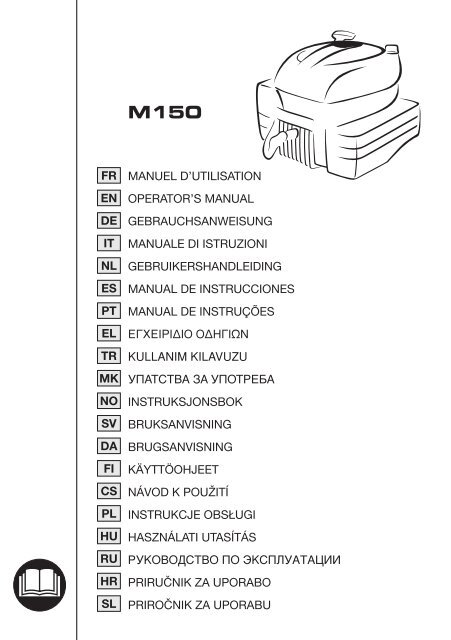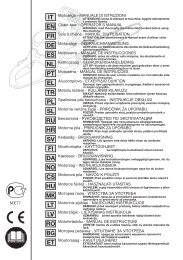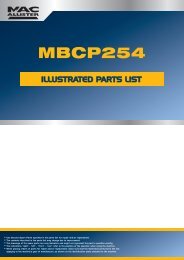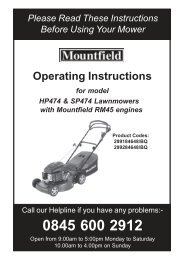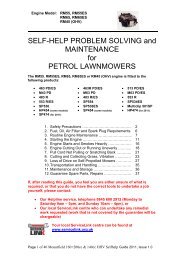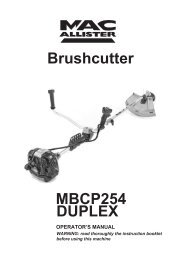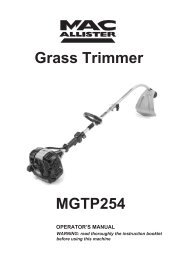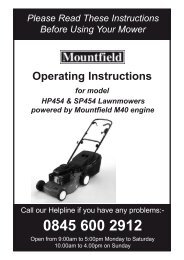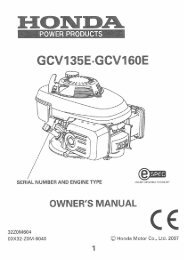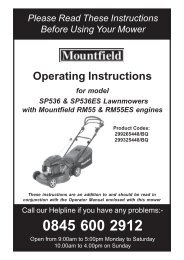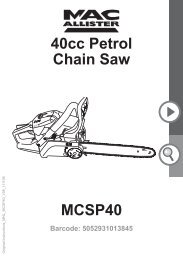Engine Manual RV150, RV40 & V35 - Service Link
Engine Manual RV150, RV40 & V35 - Service Link
Engine Manual RV150, RV40 & V35 - Service Link
Create successful ePaper yourself
Turn your PDF publications into a flip-book with our unique Google optimized e-Paper software.
M150<br />
FR<br />
EN<br />
DE<br />
IT<br />
NL<br />
ES<br />
PT<br />
EL<br />
TR<br />
MK<br />
NO<br />
SV<br />
DA<br />
FI<br />
CS<br />
PL<br />
HU<br />
RU<br />
HR<br />
SL<br />
MANUEL D’UTILISATION<br />
OPERATOR’S MANUAL<br />
GEBRAUCHSANWEISUNG<br />
MANUALE DI ISTRUZIONI<br />
GEBRUIKERSHANDLEIDING<br />
MANUAL DE INSTRUCCIONES<br />
MANUAL DE INSTRUÇÕES<br />
∂°Ã∂πƒπ¢π√ √¢∏°πø¡<br />
KULLANIM KILAVUZU<br />
УПАТСТВА ЗА УПОТРЕБА<br />
INSTRUKSJONSBOK<br />
BRUKSANVISNING<br />
BRUGSANVISNING<br />
KÄYTTÖOHJEET<br />
NÁVOD K POUŽITÍ<br />
INSTRUKCJE OBSŁUGI<br />
HASZNÁLATI UTASÍTÁS<br />
êìKéÇéÑëíÇé èé ùKëèãìÄíÄñàà<br />
PRIRUČNIK ZA UPORABO<br />
PRIROČNIK ZA UPORABU
3.1<br />
1 3 2<br />
3.2<br />
CHOKE<br />
FAST<br />
10<br />
SLOW<br />
4<br />
5 6<br />
9 7 8<br />
1<br />
STOP<br />
5.1.1<br />
1<br />
5.1.2<br />
3a<br />
2<br />
MAX<br />
MIN<br />
3<br />
1<br />
1<br />
5.1.3<br />
5.1.4<br />
2<br />
1<br />
3<br />
1 2<br />
5.2-3<br />
5.5-6<br />
CHOKE<br />
3<br />
1<br />
1<br />
3<br />
STOP
EN<br />
1<br />
TABLE OF CONTENTS<br />
1. General information ................................... 1<br />
2. Safety regulations ..................................... 1<br />
3. Components and controls ........................ 2<br />
4. What you need to know ............................ 3<br />
5. Standards of use ...................................... 4<br />
6. Maintenance ............................................. 5<br />
7. Troubleshooting ........................................ 7<br />
8. Technical data ........................................... 8<br />
1. GENERAL INFORMATION<br />
1.1<br />
READING AND UNDERSTANDING<br />
THE MANUAL<br />
Some paragraphs in the manual containing information<br />
of particular importance for safety and<br />
operation are highlighted at various levels of<br />
emphasis, and signify the following:<br />
NOTE or IMPORTANT<br />
These give details or further information on<br />
what has already been said, and aim to prevent<br />
damage either to the engine or other damages.<br />
! WARNING!<br />
Non-observance will result<br />
in the risk of injury to oneself or others.<br />
! DANGER!<br />
Non-observance will result<br />
in the risk of serious injury or death to<br />
oneself or others.<br />
NOTE All indications,<br />
“front”, “rear”, “right” and “left”,<br />
are to be taken as referring to the<br />
engine positioned with the spark<br />
plug facing forwards with respect<br />
to the observer.<br />
The number before the paragraph title refers to<br />
the text references and their related figures<br />
(shown inside front and back covers).<br />
1.2<br />
SAFETY SYMBOLS<br />
Your engine should be used with due care and<br />
attention. Symbols have therefore been placed<br />
on the engine to remind you of the main precautions<br />
to be taken. Their full meaning is explained<br />
later on.<br />
You are also asked to carefully read the safety<br />
regulations in the applicable chapter of this<br />
handbook.<br />
Warning! - Read instructions before<br />
using.<br />
Warning! - Keep away from hot surfaces.<br />
2. GENERAL SAFETY STANDARDS<br />
(to be strictly applied)<br />
A) TRAINING<br />
1) Carefully read the instructions contained<br />
in this manual and the instructions of the<br />
machine on which this engine is installed.<br />
Learn how to stop the motor quickly.<br />
2) Never allow people unfamiliar with these<br />
instructions to use the engine.<br />
3) Never use the engine while people, especially<br />
children, or pets are nearby.<br />
4) Remember that the operator or user is<br />
responsible for accidents or hazards occurring<br />
to other people or their property.<br />
B) PREPARATION<br />
1) Do not wear loose-fitting clothing, dangling<br />
drawstrings, jewels or items that could<br />
become caught; tie up long hair and keep at<br />
safe distance while starting the lawnmower.<br />
2) Turn engine OFF and let it cool before<br />
removing gas cap.<br />
3) WARNING: DANGER! Fuel is highly flammable:<br />
– store the fuel in special containers;<br />
– refuel only outdoors by using a funnel;<br />
never smoke while refueling and/or handling<br />
fuel;<br />
– add fuel before starting the engine. Never<br />
remove the cap of the fuel tank or add fuel<br />
while the engine is running or when the<br />
engine is hot;
2 EN<br />
– if you have spilt some fuel, do not attempt<br />
to start the engine but move the machine<br />
away from the area of spillage and avoid<br />
creating any source of ignition until the fuel<br />
has evaporated and fuel vapours have dissipated.<br />
– always put the tank and fuel container caps<br />
back on and tighten well.<br />
4) Replace faulty silencers and the guard, if<br />
damaged.<br />
C) OPERATION<br />
3. COMPONENTS AND CONTROLS<br />
3.1<br />
ENGINE COMPONENTS<br />
1. Rope handle<br />
2. Fuel tank fillercap<br />
3. Oil fillercap with dipstick<br />
4. Air cleaner cover<br />
5. Silencer<br />
6. Silencer guard<br />
7. Spark plug<br />
8. Spark plug cap<br />
9. Speed control lever<br />
10. <strong>Engine</strong> code<br />
1) Do not operate the engine in a confined<br />
space where dangerous carbon monoxide fumes<br />
can collect.<br />
2) Do not use starting fluids or similar products.<br />
3) Do not change the engine governor settings<br />
or overspeed the engine.<br />
4) Do not tilt the machine onto its side to prevent<br />
fuel leaks from the fuel tank cap.<br />
5) Do not touch the cylinder fins and/or the<br />
silencer guard until the engine has cooled<br />
down.<br />
6) Stop the engine and disconnect the spark<br />
plug cable before checking, cleaning or servicing<br />
the machine or the engine.<br />
7) Do not crank the engine with spark plug<br />
removed.<br />
8) Transport the machine with an empty fuel<br />
tank.<br />
3.2<br />
✍<br />
Note your engine<br />
serial number here<br />
ACCELERATOR CONTROL<br />
The throttle trigger (generally a lever), fitted to<br />
the machine, is connected to the engine by a<br />
cable (1).<br />
Consult the machine’s Instructions <strong>Manual</strong> to<br />
identify the throttle trigger and its positions, usually<br />
marked by symbols, corresponding to:<br />
D) MAINTENANCE AND STORAGE<br />
1) A routine maintenance is essential for<br />
safety and for keeping a high performance<br />
level.<br />
2) Do not store the machine with fuel in the<br />
tank in an area where the fuel vapours could<br />
reach an open flame, a spark or a strong heat<br />
source.<br />
3) Allow the engine to cool before storing in<br />
any enclosure.<br />
4) To reduce fire hazards, keep the engine,<br />
exhaust silencer, and fuel storage area free of<br />
grass cuttings, leaves, excessive grease or<br />
any other easily inflammable material.<br />
5) If the fuel tank has to be drained, this<br />
should be done outdoors once the engine has<br />
cooled down.<br />
6)On safety ground, never use the engine<br />
with either worn or damaged parts. Parts are<br />
to be replaced and not repaired. Use genuine<br />
spare parts. Parts that are not of the same<br />
quality can damage the engine and impair<br />
your safety.<br />
CHOKE = to be used for cold starting.<br />
FAST<br />
= corresponds to maximum revs;<br />
to be used when working.<br />
SLOW = slowest speed.<br />
STOP<br />
= engine stop (if fitted).
EN<br />
3<br />
4. WHAT YOU NEED TO KNOW<br />
The engine performance, reliability and life are<br />
influenced by many factors, some external and<br />
some strictly associated with the quality of the<br />
products used and with the scheduled maintenance.<br />
The following information allow a better understanding<br />
and use of your engine.<br />
4.1<br />
ENVIRONMENTAL CONDITIONS<br />
The operation of a four-stroke endothermic<br />
engine is affected by:<br />
a) Temperature:<br />
– Working in low temperatures could lead to a<br />
difficult cold starting.<br />
– Working in very high temperatures could lead<br />
to a difficult hot starting due to the evaporation<br />
of the fuel either in the carburetor float<br />
chamber or in the pump.<br />
– In any case, the right kind of oil must be used,<br />
according to the operating temperatures.<br />
a) Use only detergent oil classified SF-SG.<br />
b) Choose the SAE viscosity grade of oil from<br />
this chart:<br />
– from 5 to 35 °C = SAE 30<br />
– from -15 to + 5 °C = 5W-30 or 10W-30<br />
(Multi-viscosity)<br />
– from -25 to + 35 °C = Synthetic oils<br />
5W-30 or 10W-30<br />
(Multi-viscosity)<br />
c) The use of multi-viscosity oils in hot temperatures<br />
will result in higher than normal oil consumption;<br />
therefore, check oil level more frequently.<br />
d) Do not mix oils of different brands and features.<br />
e) SAE 30 oil, if used below 5°C, could result in<br />
possible engine damage due to inadequate<br />
lubrication.<br />
f) Oil should be at “MAX” mark (see 5.1.1): do<br />
not overfill. Overfilling with oil may cause:<br />
– Smoking;<br />
– Spark plug or air filter fouling, which will<br />
cause hard starting.<br />
b) Altitude:<br />
– The higher the altitude (above sea level), the<br />
lower the max power developed by an<br />
endothermic engine.<br />
– When there is a considerable increase in altitude,<br />
the load on the machine should be<br />
reduced and particularly heavy work avoided.<br />
4.2<br />
FUEL<br />
A good quality fuel is the major issue for the<br />
engine reliability of operation.<br />
a) Use unleaded gasoline, with a minimum of 90<br />
octane.<br />
b) Use clean, fresh fuel; purchase fuel in quantity<br />
that can be used within 30 days, to prevent<br />
gum from forming inside the container or the<br />
tank.<br />
c) Do not use fuel which contains Methanol.<br />
d) Do not add neither oil nor any kind of fuel<br />
additive.<br />
4.3<br />
OIL<br />
Use always high quality oils, choosing their viscosity<br />
grade according to the operating temperature.<br />
4.4<br />
AIR FILTER<br />
The air filter must always be in perfect working<br />
order, to prevent debris, dirt or dust from getting<br />
sucked into the engine, reducing the efficiency<br />
and working life of the machine.<br />
a) Always keep the filter element free of debris<br />
and dirt in perfect working order (see 6.5).<br />
b) If necessary, replace the filtering element with<br />
an original spare part. Incompatible filtering<br />
elements can impair the efficiency and life of<br />
the engine.<br />
c) Never start the engine without mounting the<br />
filtering element properly.<br />
4.5<br />
SPARK PLUG<br />
Not all the spark plugs for endothermic engines<br />
are the same!<br />
a) Use only spark plugs of the recommended<br />
type, with the right heat range.<br />
b) Check the length of the thread, because – if<br />
too long – it will damage the engine beyond<br />
repair.<br />
c) Make sure that the electrodes are clean and<br />
their gap is correct (see 6.6).
4 EN<br />
5. STANDARDS OF USE<br />
5.1<br />
BEFORE EVERY USE<br />
Before every use, perform the following checking<br />
procedures in order to assure a regular operation.<br />
5.1.1<br />
Check oil level<br />
See the specific chapter (see 8.1) for the oil to be<br />
used.<br />
a) Place engine level.<br />
b) Clean around oil fill.<br />
c) Remove the fillercap (1), clean the tip of the<br />
dipstick (2), insert and tighten down.<br />
d) Remove dipstick again and check the oil level<br />
that must be between the “MIN” and “MAX”<br />
marks.<br />
e) If oil is required, add oil of the same kind up<br />
to the “MAX” mark, being careful not to spill<br />
any outside the oil fill.<br />
f) Close the fillercap (1) and wipe off any spilled<br />
oil.<br />
5.1.2<br />
Air filter check<br />
The efficiency of the air filter is fundamental for<br />
the engine to work properly. Do not start the<br />
engine if the filtering element is missing or broken.<br />
a) Clean the area around the filter cover (1).<br />
b) Remove the cover (1) by releasing the rear<br />
tab (2) and check the condition of the filtering<br />
element (3 - 3a). It must be intact, clean and<br />
in perfect working order; if not, either replace<br />
it or carry out maintenance (see 6.5).<br />
c) Remount the cover (1).<br />
c) Remove the fillercap (1).<br />
d) Using a clean funnel (2), fill tank to approximately<br />
5 mm below the inner edge of the filler<br />
neck (3), being careful not to spill fuel.<br />
e) Tighten the fillercap (1) back and clean any<br />
spilled fuel.<br />
5.1.4<br />
Spark plug cap<br />
Firmly connect the cable cap (1) to the spark<br />
plug (2), making sure that there are no traces of<br />
debris or dirt inside the cap or on the spark plug<br />
terminal.<br />
5.2<br />
STARTING THE ENGINE (cold starting)<br />
The engine must only be started when all the<br />
accessory devices are disconnected (if fitted on<br />
the machine) and when the gear (where fitted) is<br />
in neutral.<br />
a) Move throttle control (1) to “CHOKE” position.<br />
b) Set the machine controls as indicated in the<br />
machine’s Instructions <strong>Manual</strong>.<br />
c) Grasp rope handle (3) and pull slowly until<br />
resistance is felt. Then pull cord rapidly.<br />
d) When engine starts, release the rope.<br />
e) After a few seconds, slowly move throttle (1)<br />
from “CHOKE” to “FAST” or “SLOW” position.<br />
NOTE If the engine does not start,<br />
repeat from section b).<br />
NOTE If the engine starts but does<br />
not keep running, repeat the whole starting<br />
procedure with throttle control in “FAST” position.<br />
5.1.3<br />
Adding fuel<br />
5.3<br />
STARTING THE ENGINE (hot starting)<br />
IMPORTANT Do not drip petrol onto the<br />
plastic parts of the motor or the machine to<br />
prevent damaging them and remove all traces<br />
of spilt petrol immediately. The warranty does<br />
not cover damage to plastic parts caused by<br />
petrol.<br />
See the specific chapter (see 8.1) for the fuel<br />
characteristics.<br />
Add fuel only when the engine is cold.<br />
a) Place the lawnmower level.<br />
b) Clean around the fillercap (1).<br />
•) Follow the whole cold-starting procedure<br />
with throttle control (1) in “FAST” position.<br />
5.4<br />
USE OF THE ENGINE IN OPERATION<br />
Maximum revs must be used to optimise the<br />
engine’s yield and performance, by setting the<br />
throttle lever to “FAST”.<br />
! WARNING!<br />
Keep your hands away<br />
from the silencer and surrounding areas<br />
that can become extremely hot. With the
EN<br />
5<br />
engine running, do not get loose-fitting<br />
clothing (ties, scarves, etc.) or hair closer to<br />
the top part of the engine.<br />
IMPORTANT Do not operate on over 15°<br />
inclines to prevent malfunctioning of the<br />
engine.<br />
5.5<br />
STOPPING DURING OPERATION<br />
a) Move the throttle (1) to “SLOW”.<br />
b) Stop the engine as described in the machine’s<br />
instructions manual.<br />
5.6<br />
STOPPING AT THE END<br />
OF OPERATION<br />
a) Move the throttle (1) to “SLOW”.<br />
b) Stop the engine as described in the machine’s<br />
instructions manual.<br />
c) Once the engine has cooled, disconnect the<br />
spark plug cap (3).<br />
d) Remove all traces of debris or dirt from the<br />
engine and especially around the exhaust<br />
silencer to reduce the risk of fire<br />
6. MAINTENANCE<br />
6.1<br />
SAFETY RECOMMENDATIONS<br />
! WARNING!<br />
Remove the spark plug<br />
cap and read instructions before carrying<br />
out any cleaning, repair or maintenance<br />
operation. Wear proper clothing and working<br />
gloves whenever your hands are at risk.<br />
Do not perform maintenance or repair operations<br />
without the necessary tools and<br />
technical knowledge.<br />
IMPORTANT Never get rid of used oil, fuel<br />
or other pollutants in unauthorised places.<br />
IMPORTANT If necessary (if foreseen in<br />
the Machine’s Instruction <strong>Manual</strong>), the engine<br />
can be laid down on its left side, or the front<br />
part can be lifted, taking care not to allow oil or<br />
fuel to leak out.<br />
6.2<br />
MAINTENANCE SCHEDULE<br />
Follow the hourly or calendar – whichever occur<br />
first – maintenance schedule shown in the following<br />
table.<br />
5.7<br />
CLEANING AND STORAGE<br />
a) Do not spray with water or use hydraulic<br />
lances to clean the exterior of the engine.<br />
b) Preferably use a compressed air gun (max. 6<br />
bars), to prevent debris, dirt or dust from penetrating<br />
inside the machine.<br />
c) Store the lawnmower (and the engine) in a dry<br />
place, sheltered from severe weather conditions<br />
and sufficiently ventilated.<br />
5.8<br />
LONG STORAGE (over 30 days)<br />
In case the engine has to be stored for a long<br />
time (for example at the end of the season), a<br />
few precautions are needed to help the future<br />
start-up.<br />
a) Drain fuel from tank to prevent build-ups<br />
inside the tank.<br />
b) Remove the spark plug and pour inside the<br />
spark plug hole about 3 cl of clean engine oil.<br />
Close the hole with a cloth, then pull, slowly<br />
and carefully, the starting rope so that, with a<br />
few engine revolutions, the oil will be distributed<br />
on the cylinder inner walls. Reinstall the<br />
spark plug without connecting the cable cap.<br />
Operation<br />
After First 5 hours<br />
Every 5 hours or<br />
daily<br />
Every 25 hours or<br />
every season<br />
Every 50 hours or<br />
every season<br />
Every 100 hours<br />
Check oil level<br />
(see 5.1.1)<br />
- ✔ - - -<br />
Change oil 1)<br />
(see 6.3)<br />
✔ - - ✔ -<br />
Clean silencer and<br />
engine (see 6.4)<br />
- - ✔ - -<br />
Check air cleaner 2)<br />
(see 6.5)<br />
- - ✔ - -<br />
Oil air cleaner 2)<br />
(see 6.5)<br />
- - ✔ - -<br />
Check spark plug<br />
(see 6.6)<br />
- - ✔ - -<br />
Replace spark plug<br />
(see 6.6)<br />
- - - ✔ -<br />
1)<br />
Change oil every 25 hours if the engine is operating<br />
under heavy load or in ht weather.<br />
2)<br />
Clean air cleaner more frequently if the<br />
machine is operating in dusty areas.
6 EN<br />
6.3 CHANGE OIL<br />
any dust, debris or dirt, taking care not to<br />
push anything into the induction pipe (5).<br />
See the specific chapter (see 8.1) for the oil to be<br />
e) Put the filtering element (3 - 3a) back in place<br />
used.<br />
and close the cover (1).<br />
! WARNING!<br />
Drain oil while the engine<br />
is warm, being careful not to touch the hot<br />
engine nor the drained oil.<br />
a) Place engine level.<br />
b) Clean around oil fill (1).<br />
c) Remove the fillercap (1).<br />
d) Have a container ready (2) to collect the oil.<br />
e) Lay the engine on its left side to allow the oil<br />
to flow from the refill inlet (3) or follow the procedures<br />
indicated in the Machine’s Instruction<br />
<strong>Manual</strong>.<br />
f) When the engine is upright, top it up with new<br />
oil.<br />
g) Check the oil level on the dipstick (4). Oil<br />
should be at “MAX” mark.<br />
h) Close the fillercap and wipe off any spilled oil.<br />
• Sponge filtering element (3)<br />
Keep the filtering element clean and soaked in<br />
oil. Replace it if it is disintegrating, cut or broken.<br />
IMPORTANT Do not use compressed air<br />
to clean the filtering element.<br />
– Clean the sponge filtering element with water<br />
and detergent and dry it with a clean cloth.<br />
– Soak the filtering element in 2 tablespoonfuls<br />
of clean engine oil and wring it well to distribute<br />
the oil evenly.<br />
– Remove any excess oil with a clean cloth.<br />
If you need to replace the filtering element, oil<br />
the new filter as described above.<br />
NOTE<br />
liter.<br />
The oil capacity is about 0.6<br />
• Cartridge filtering element (3a)<br />
– Blow compressed air from the inside to remove<br />
dust and debris.<br />
6.4<br />
CLEAN SILENCER AND ENGINE<br />
IMPORTANT Do not use water, petrol,<br />
detergents or any other products to clean the<br />
filtering element.<br />
Silencer must be cleaned when the engine is<br />
cold.<br />
a) Use a jet of compressed air or a brush to remove<br />
any debris and dirt that could cause a<br />
fire from the silencer (1) and its protective<br />
cover (2).<br />
b) Clean the cylinder and cylinder head fins (3)<br />
to ease engine cooling and prevent overheating.<br />
c) Clean the plastic components with a sponge<br />
(4) soaked in water and detergent.<br />
6.6<br />
SPARK PLUG SERVICE<br />
a) Remove the spark plug (1) using a spark plug<br />
socket wrench (2).<br />
b) Clean the electrodes (3) with a metal brush<br />
and remove any carbonaceous build-up.<br />
c) Using a thickness gauge (4), check for the<br />
right gap (0.6 - 0.8 mm) between the electrodes.<br />
d) Install the spark plug (1) and tighten with a<br />
socket wrench (2).<br />
6.5<br />
AIR FILTER MAINTENANCE<br />
Replace the spark plug if the electrodes are<br />
burnt or if the porcelain is broken or damaged.<br />
a) Clean the area around the filter cover (1).<br />
b) Remove the cover (1) by releasing the rear<br />
tab (2) and remove the filtering element (3 -<br />
3a).<br />
c) Carry out maintenance on the filtering element<br />
as described below for each type.<br />
d) Clean inside the filter housing (4) to get rid of<br />
! WARNING!<br />
Fire hazard! Do not check<br />
the ignition system with spark plug removed.<br />
IMPORTANT Use only spark plugs of the<br />
recommended type (see 8.1).
EN<br />
7<br />
6.7 ADJUSTMENT OF THE<br />
b) Loosen the screw (1) of the clamp (2) so that<br />
ACCELERATOR CABLE<br />
the cable casing (3) is free to move.<br />
If the engine does not reach its maximum rpm<br />
with the throttle control in “FAST” position, this is<br />
likely due to an out-of-phase connection between<br />
the accelerator lever and the governor lever.<br />
To restore the correct phase:<br />
a) Stop the engine, remove the spark plug cap<br />
and wait until the engine has cooled.<br />
c) Move the throttle control to “SLOW”.<br />
d) Move governor control lever (4) forward as far<br />
as possible and, by keeping it in this position,<br />
lock the casing (3) full tightening the screw (1)<br />
of the clamp (2).<br />
7. TROUBLESHOOTING<br />
PROBLEM LIKELY CAUSE SOLUTION<br />
a) Hard starting<br />
– No fuel<br />
– Stale fuel or build-ups in tank<br />
– Incorrect starting procedure<br />
– Spark plug disconnected<br />
– Check and top up (see 5.1.3)<br />
– Empty fuel tank and refill with fresh fuel<br />
– Perform the starting procedure correctly<br />
(see 5.2)<br />
– Check that the spark plug cap fits well<br />
over the plug terminals (see 5.1.4)<br />
– The spark plug is wet or the spark plug<br />
electrodes are dirty or placed inadequately<br />
– Check (see 6.6)<br />
– Air filter clogged<br />
– Incorrect oil for the season<br />
– Fuel evaporation in the carburetor<br />
(vapor lock) due to high temperatures<br />
– Fault in carburation<br />
– Hard starting<br />
– Check and clean (see 6.5)<br />
– Replace with proper oil (see 6.3)<br />
– Wait for a few minutes then start again<br />
(see 5.3)<br />
– Contact a Licensed <strong>Service</strong> Centre<br />
– Contact a Licensed <strong>Service</strong> Centre<br />
b) Inconsistent<br />
working<br />
– Dirty electrodes or incorrect gap<br />
– The spark plug cap is inserted incorrectly<br />
– Air filter clogged<br />
– Throttle trigger in “CHOKE” position<br />
– Fault in carburation<br />
– Fault in ignition<br />
– Check (see 6.6)<br />
– Check that the cap is fitted correctly<br />
(see 5.1.4)<br />
– Check and clean (see 6.5)<br />
– Move the lever to the “FAST” position<br />
– Contact a Licensed <strong>Service</strong> Centre<br />
– Contact a Licensed <strong>Service</strong> Centre<br />
c) Loss of power<br />
whilst operating<br />
– Air filter clogged<br />
– Fault in carburation<br />
– Governor out of phase with respect<br />
to the accelerator<br />
– Check and clean (see 6.5)<br />
– Contact a Licensed <strong>Service</strong> Centre<br />
– Adjust the cable (see 6.7)
8 EN<br />
8. TECHNICAL SPECIFICATIONS<br />
8.1<br />
REFILLING AND OPERATION MATERIALS<br />
Fuel .......................................................................................... Unleaded gasoline, minimum 90 octane<br />
Tank capacity .............................................................................................................................. 0.8 liter<br />
<strong>Engine</strong> oil: from 5 to 35 °C......................................................................................................... SAE 30<br />
from -15 to +5 °C .................................................................................... 5W-30 or 10W-30<br />
from -25 to +35 °C .................................................................. Synthetic 5W-30 or 10W-30<br />
Oil capacity .................................................................................................................................. 0.6 liter<br />
Spark plug ......................................................................................... QJI9LM (Champion) or equivalent<br />
Spark plug gap ................................................................................................................... 0.6 - 0.8 mm
6.3<br />
1<br />
6.4<br />
3<br />
4<br />
MAX<br />
MIN<br />
2<br />
4<br />
3<br />
1 2<br />
6.5<br />
4<br />
5<br />
3<br />
3a<br />
2 1<br />
1<br />
6.6<br />
1<br />
3<br />
0,6-0,8<br />
mm<br />
2<br />
4<br />
1 1<br />
6.7<br />
3<br />
1<br />
4<br />
2<br />
Manufactured by:<br />
SUMEC - Nanjing, China
© by GGP - ITALY<br />
GGP ITALY SPA<br />
Via del Lavoro, 6<br />
I-31033 Castelfranco Veneto (TV) ITALY<br />
71520122/2 Realizzazione: EDIPROM / bergamo


